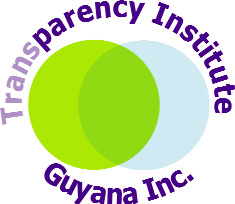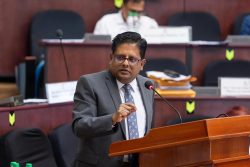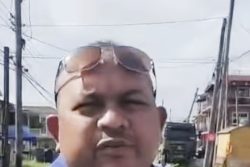(This is the fourth in a series of articles by Transparency Institute Guyana Inc on the Production Sharing Agreement signed between the Government of Guyana and Esso Exploration and Production Guyana Limited, a subsidiary of ExxonMobil.)
We continue our analysis of the arrangement with Exxon by looking at the claim that the Venezuelan belligerence was the justification for the selection of Esso/Exxon and that this belligerence constituted special circumstances under Section 13(3) of the Regulations made pursuant to the 1986 Petroleum act.
Both governments since the signing of these contracts have sought to represent the “special circumstances” required by the regulations to justify exceeding the maximum as the continued pressure exerted by Venezuela resulting in lack of interest on the part of oil companies. In order to understand this situation, we need a frame of reference starting in 1991. In November 1991, a conference was held at the University of Miami, Florida and proceedings were reported in a booklet titled “Guyana at the crossroads” (Watson & Craig, 1992).
Mr. Winston Murray, then Deputy Prime Minister of Guyana, said the following in response to Mr. Robert Traurig, Chairman Greater Miami Chamber of Commerce, Miami:
“…The government, therefore, set out on a very deliberate policy to nurture foreign investment. In 1988, an investment policy paper was debated and approved by the National Assembly. This set out very clearly the ground rules under which foreign investors could and would operate.
We had the courage to repeal the old Petroleum Act and replace it with a more relevant one. Gold and Diamond Mining Regulations were amended.
As a result of a more conducive environment today there are foreign companies exploring on-shore and off-shore for petroleum. And there are growing implications that petroleum could be found in significant commercial quantities in Guyana in the near future.” (Watson & Craig, 1992, p. 5).
Then Opposition members or opponents of the government led by Mr. Murray at the time including Drs Rupert Roopnaraine and Roger Luncheon, were recorded as present and none were recorded as challenging this statement. The record shows that several of DPM Murray’s claims were challenged but that no one challenged his claims regarding the petroleum exploration investors. The conference was also attended by recognizable names such as the late Professor Festus Brotherson, Dr.Selwyn Ryan (UWI), and Dr. Yesu Persaud (see Watson & Craig, 1992).
So, in open forum, the Deputy PM said that there were foreign companies exploring onshore and offshore for petroleum. This is at 180 degree variance from what was represented in March 2018 in a Guyana Chronicle article that claimed that “companies had refused to invest billions of dollars in an area that was being threatened by another country. The companies deliberately stayed away from exploring the basin and this placed Guyana in a position of “high risk” (Guyana Chronicle, March 6, 2018).
The record shows that it was on the 13th of July 1999 that the government of Hugo Chavez sent a protest note to the Government of Guyana (GOG). He was protesting the granting of concessions to oil companies in Guyana. The contracts were, of course, signed before the Venezuelan Government protested. In fact, the date of signature of the 1999 contract is 14th June 1999.
With regard to the period between 1991 and 1998, it is a period when Venezuela was in ferment with its own internal politics with events associated with the rise of Hugo Chavez including a coup in 1992 and his election to office in 1998.
We can safely conclude that whatever pressure Venezuela was exerting was too late to influence the great interest being shown by oil companies as described by Mr. Winston Murray at the 1991 conference.
But, the smallest child knows that Venezuela has kept up pressure on Guyana, declaring a newly minted claim for the seabed now extending far beyond her previous claim. So one can surmise that the spectre of this hostility loomed large regardless.
However, the literature available at the time suggests that Guyana did not appear too worried about this. In fact, quite the contrary, it suggests that the GOG had perceived some kind of detente. After all, it was only in July of the previous year (1998) that Mrs Jagan, the then president of Guyana, made a high-level visit to Caracas. To quote from the Guyana Chronicle of July 23, 1998 (as represented in the Guyana Land of Six Peoples online archive), “She and an accompanying 21-member Government and private sector delegation continued a two-day visit yesterday, after arriving Tuesday to a red carpet welcome.
The two Presidents also held an hour-long meeting yesterday, underscoring the need for closer ties and dialogue to establish lasting and firm relations, a report from the delegation said.”
Note well that we are not saying that there was no threat from Venezuela. Clearly, subsequent and very recent developments would not allow us to forget it. The issue is whether at the time of signing of the 1999 contract with Esso, the government of Guyana would have (a) taken such a thing into account given the friendly relations that had been established and that persisted from July 1998 up to the time of signing the contract, and (b) been intimidated enough during what was a lull in Venezuelan hostility to feel it needed protection from Exxon. In fact, a Chronicle article of March 6, 2018 titled “Exxon helping to stir interest of foreign investors” suggests that it was only after the seizure of Anadarko’s research vessel in 2013 that a “consensus” was arrived at that “a major oil company” was needed to explore Guyana’s resources.
Therefore, Venezuela, as a special circumstance to justify variation of the 60-block maximum appears to be an overstatement if not a complete misrepresentation. We know of no other “special circumstances” identified by any government minister, past or present.
No Value for Money
But whatever price the GOG paid for protection from Exxon did not turn out to be value for money. While this would not have been known at the time of the signing of the 1999 contract, certainly it should have been realized in 2016. In fact, there would appear to have been a breach of this implied term of the contract by Exxon (i.e., that it was expected to stand up to Venezuela as part of the bargain). We say this because it is clear that Exxon’s discovery of oil was not made as a result of standing up to Venezuela but by doing the exact opposite!
Bill Drennen, Vice President for the Americas with ExxonMobil is quoted as having said that “There are still some areas that are sufficiently in the middle to be far enough away from these disputes, offering a more comfortable position” (Kaieteur News, February 5, 2007 as represented in the Guyana Land of Six Peoples archive).
The very Chronicle article we referenced earlier (March 6, 2018) quoted an anonymous government official as saying “… that it was during routine drilling by Exxon to maintain their exploration contract with Guyana that they struck oil. “It was somewhat unintentional on the part of Exxon since originally they had chosen to drill a different well and later found oil.” The discovery of oil by Exxon had nothing to do with standing up to Venezuela. They literally backed away and stumbled upon oil!
In fact, Guyana’s ambassador to Suriname Keith George, at the University of Guyana’s Conversation on Law and Society, noted that it was the settlement of the maritime border with Suriname that made Exxon’s exploration possible He said, “If it weren’t for the 2007 Arbitral Award, Liza would not have existed. Liza is just a few kilometres away from where Suriname itself was claiming and Exxon would have been even more fearful because of what Suriname did in June, 2000; it used its gunboats” (SN, February 3, 2018),
It is notable that only Guyanese officials appear to attribute value to Exxon as some kind of insurance against Venezuelan aggression. Neither in words nor actions does Exxon appear to be aware of this expectation on its part.
In our next article will show that the bundling of what should have been 6 separate licences into one was completely unnecessary and benefited only one party to the disadvantage of the other.









